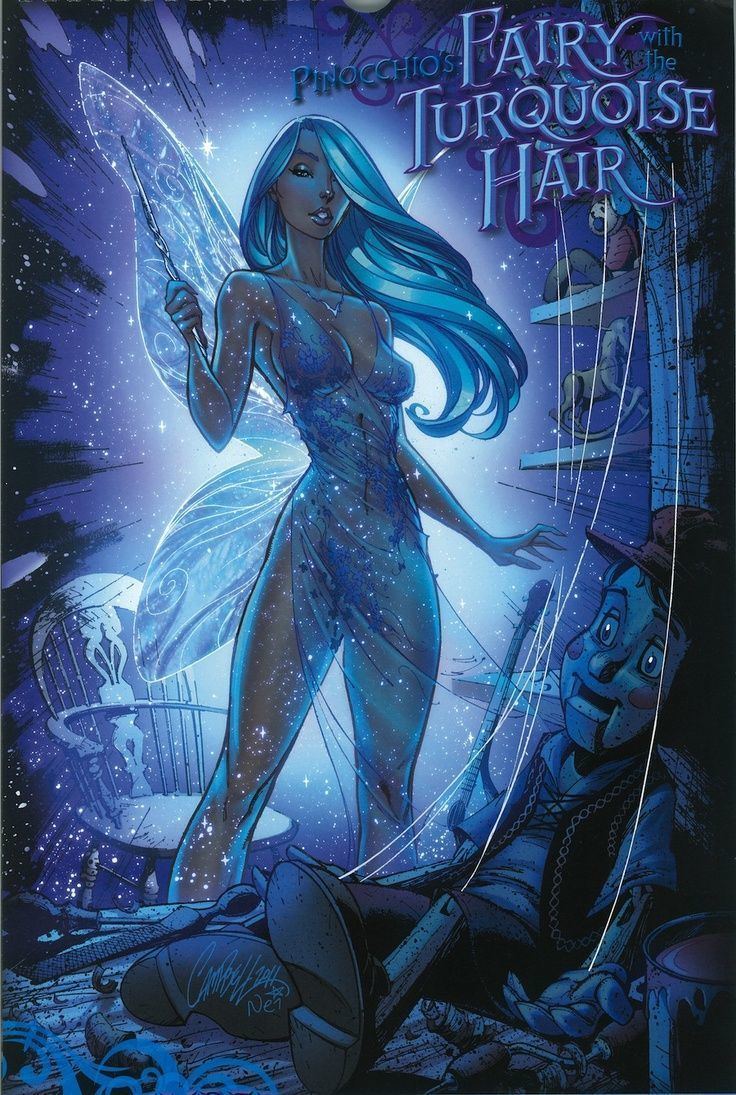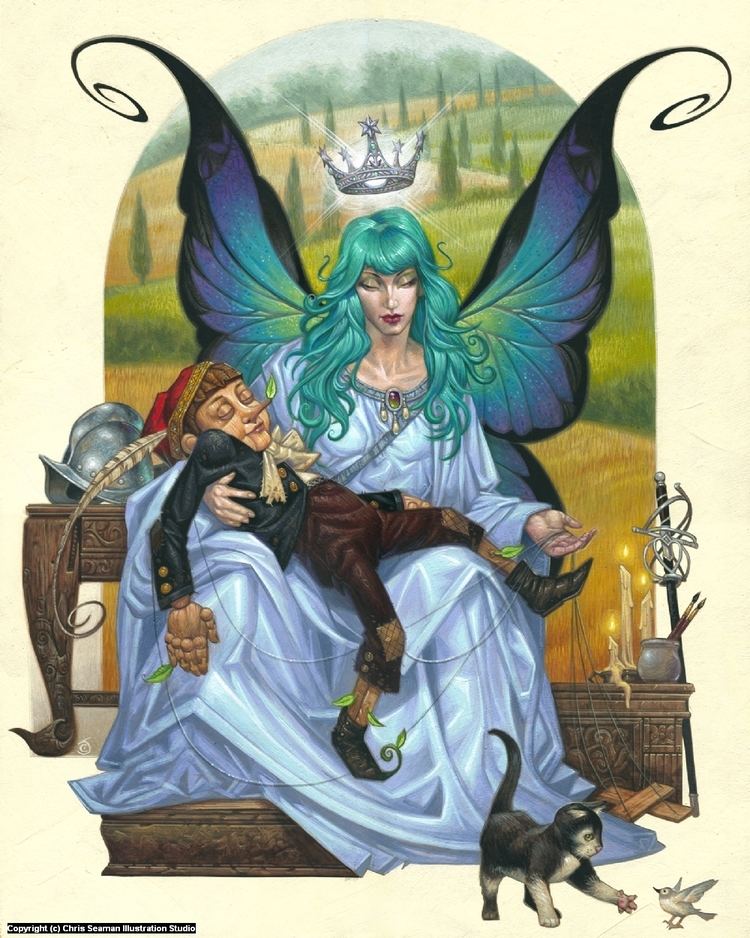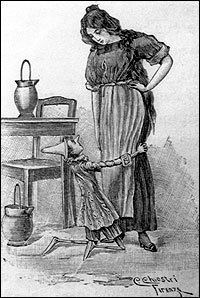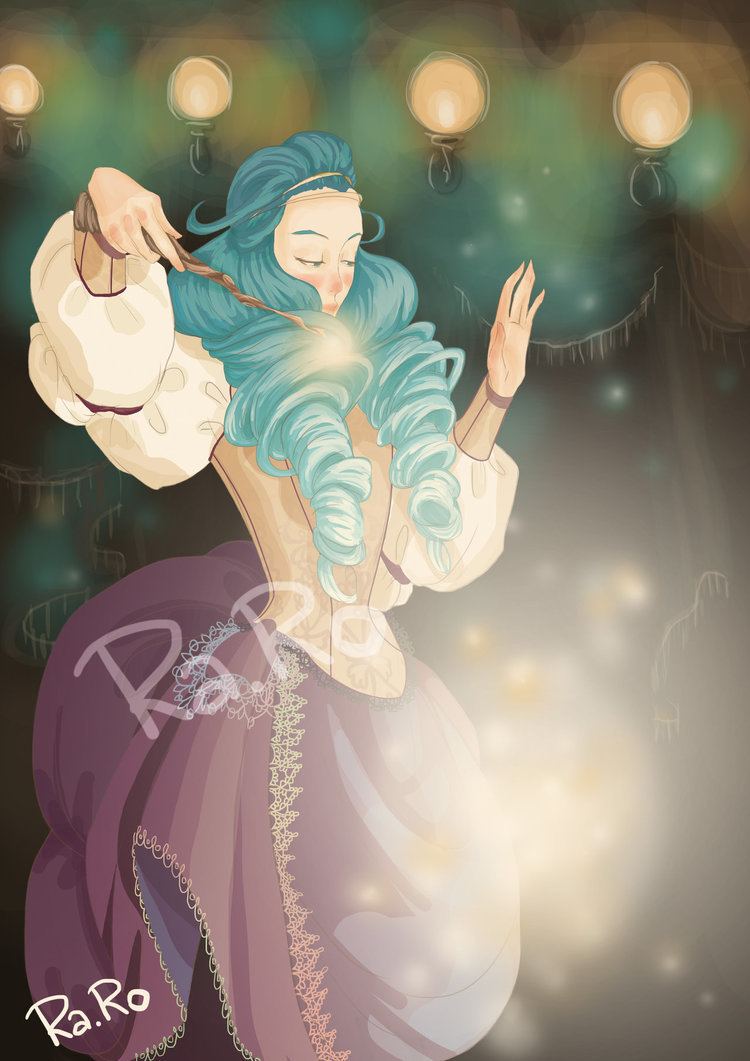Created by Carlo Collodi Nationality Italian Species Fairy | Gender Female Creator Carlo Collodi | |
 | ||
First appearance The Adventures of Pinocchio Movies and TV shows Pinocchio, Geppetto, The Adventures of Pinocchio, Pinocchio: The Series Played by Evelyn Venable, Gina Lollobrigida, Nicoletta Braschi, Julia Louis‑Dreyfus, Vittoria Febbi Similar Geppetto, Jiminy Cricket, Pixie, Pinocchio, Candlewick | ||
The fairy with turquoise hair
The Fairy with Turquoise Hair (Italian: La Fata dai Capelli Turchini, often simply referred to as La Fata Turchina) is a fictional character in Carlo Collodi's 1883 book The Adventures of Pinocchio. She repeatedly appears at critical moments in Pinocchio's wanderings to admonish the little wooden puppet to avoid bad or risky behavior. Although the naïvely willful marionette initially resists her good advice, he later comes to follow her instruction. She in turn protects him, and later enables his assumption of human form, contrary to the prior wooden form.
Contents

The character is the inspiration for the Blue Fairy in Disney's adaptation of the story.
Role

The Fairy with Turquoise Hair makes her first appearance in chapter XV, where she is portrayed as a young girl living in a house in the middle of a forest. Pinocchio, who is being chased by The Fox and the Cat (Il Gatto e la Volpe), pleads with the Fairy to allow him entrance. The Fairy cryptically responds that all inhabitants of the house, including herself, are dead, and that she is waiting for her coffin to arrive. The pair catches and hangs Pinocchio from a tree. In the following chapter, it is established that the girl is a fairy who has lived in the forest for more than a thousand years. She takes pity on Pinocchio, and sends a falcon to take him down from the tree and for her poodle servant Medoro to prep her stagecoach. After a visit from three doctors consisting of an Owl, a Crow, and the Talking Cricket (Il Grillo Parlante), the Fairy attempts to give Pinocchio medicine in order to heal his injuries. Pinocchio refuses to take the medicine on account of its sour taste, prompting the Fairy to summon a group of coffin-bearing undertaker rabbits. Frightened by this display, Pinocchio drinks the medicine, and later tells the Fairy of his previous adventures. When he includes untruths, his nose begins to lengthen, which the Fairy explains is due to his lies. She summons a group of woodpeckers to shorten the disproportionate nose, and after forgiving Pinocchio, informs him that he is free to consider her an elder sister, and that his father Mister Geppetto is on his way to fetch him. In his impatience, Pinocchio leaves the house in an attempt to meet his father on the way.

Four months later after spending some time in the Catchfools prison, Pinocchio returns to the Fairy's house only to find a tombstone declaring that the Fairy died believing that Pinocchio had abandoned her. In the following chapter, Pinocchio is transported to the Island of Busy Bees (Isola delle Api Industriose), where he meets the Fairy, now older, disguised as an ordinary woman. Unaware of the deception, Pinocchio offers to carry buckets of water to her house in exchange for a meal. After eating, Pinocchio recognises the Fairy's turquoise hair. The Fairy agrees to adopt him as her son, and promises to turn him into a real boy, provided he earns it through hard study and obedience for one year. Later, she reveals to Pinocchio that his days of puppethood are almost over, and that she will organise a celebration in his honour; but Pinocchio is led by Lampwick (Lucignolo) to the Land of Toys (Paese dei Balocchi).

Five months later, Pinocchio is transformed into a donkey, and later thrown into the sea by his handler. Whereupon the Fairy sends a shoal of fish to consume his donkey's appearance until he is returned to his puppet form. Taking the form of a blue-furred mountain goat, the Fairy warns Pinocchio of the impending arrival of The Terrible Dogfish, but is unsuccessful. It is revealed in chapter XXXVI that she gives a house to the Talking Cricket (who offers to accommodate both Pinocchio and the sickly Geppetto) while she was in the form of the blue-furred mountain goat. The Fairy becomes ill too, so Pinocchio gives some of the money he's earned to her snail to give to her. She finally appears to Pinocchio in a dream, and commends him for having taken care of his ailing father and herself. Upon awakening, Pinocchio has become human, and all his copper coins have turned to gold, accompanied by a note from the Fairy professing her responsibility.
Media portrayals

In Walt Disney's Pinocchio, the Fairy (voiced by Evelyn Venable) is referred to as The Blue Fairy, and is one of the four leading protagonists in the film. It is she who brings Pinocchio to life and having appointed Jiminy Cricket as Pinocchio's conscience. She is also the love interest of Jiminy Cricket. She is also shown to be a blonde with blue eyes, rather than having the turquoise hair and black eyes of her book counterpart.

In Giuliano Cencis' 1972 adaptation Un burattino di nome Pinocchio, the Fairy (voiced by Vittoria Febbi with Martha Scott doing her English-voice dub) is portrayed much more accurately to the book than she is in the Disney adaptation. She has no role in creating Pinocchio, though she does offer him guidance and support. Though she is accurately portrayed as sporting blue hair, she does not physically age as she does in the book.
In Pinocchio and the Emperor of the Night, the Good Fairy (voiced by Rickie Lee Jones) appears as Pinocchio's guide. In the beginning she arrives at his birthday party and brings to life his glowworm, which he names Gee Willikers. Later, she brings him back to life after he has been turned back into a puppet by Puppetino and tells him to make the right choices. After the defeat of the Emperor, she restores Pinocchio, brings back Geppetto's jewel box which had been stolen earlier, and brings Twinkle, a girl who had been turned into a puppet, back to life.
In the 1992 direct to video adaptation by GoodTimes Entertainment, the Fairy (voiced by Jeannie Elias) is portrayed more like her Disney counterpart with blonde hair instead of turquoise. She is soft-spoken and sweet. She is also a motherly figure to Pinocchio and guides him. She also has a broken heart when she realizes that Pinocchio is swallowed by whale, but Pinocchio becomes good and repays her kindness by doing the good things.
In Happily Ever After: Fairy Tales for Every Child, the Fairy is actually called "the Blues Fairy" (voiced by Della Reese) and is like her Disney counterpart who tells Pinocchio a.k.a. Pinoak what is right and what is wrong.
In the TV musical Geppetto, the Fairy makes an appearance (played by Julia Louis-Dreyfus) and is portrayed like her Disney counterpart under the name "Blue Fairy".
In Steven Spielberg's 2001 movie A.I.: Artificial Intelligence (2001), the Blue Fairy (voiced by Meryl Streep) appears as a plot MacGuffin. The main character David, a robotic child played by Haley Joel Osment, believes that the Blue Fairy has the power to turn him into a real boy. It also appears in the form of the Coney Island statue of the Blue Fairy which David mistakes for a real blue fairy.
In Buratino, the Russian adaptation of Pinocchio, there is a female character with blue hair named Malvina.
In Roberto Benigni's Pinocchio, the Blue Fairy is portrayed by Italian actress Nicoletta Braschi with her English-dubbed voice provided by Glenn Close.
Angelica, the Blue Fairy, is the antagonist in the Japanese/Australian stage show Once Upon a Midnight.
The Blue Fairy was a 1950s' children's program on WGN-TV in Chicago, hosted by Brigid Bazlen as the fairy.
In a 1997 article for the Miami New Times, reporter Lynda Edwards describes hearing modern urban legends from Miami's homeless children, who cope with their situation by invoking Latino and Afro-Cuban legends including the image of "the pale blue lady" or blue fairy. Derived from the Catholic legend of the Blessed Mother leading a spiritual army of angels, the Blue Lady protects the children from poverty-related terrors, against the minions of a vengeful La Llorona.
Actress Keegan Connor Tracy plays the Blue Fairy in ABC's Once Upon a Time. In the series, the residents of Storybrooke, Maine are former fairytale characters with their memories wiped by a curse cast by the Evil Queen from the tale of Snow White. The good fairies from the fairytale world are transformed into the nuns of Storybrooke's local convent, with the Blue Fairy as Mother Superior. Her history with Pinocchio is still intact.
In the Vertigo comic series Fables she appears as a blue haired fairy who makes Pinocchio into a (never-aging) boy.
